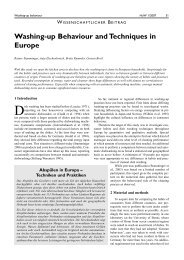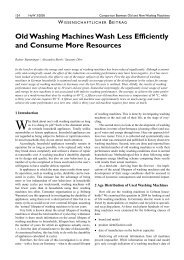Development of a novel mechatronic system for mechanical weed ...
Development of a novel mechatronic system for mechanical weed ...
Development of a novel mechatronic system for mechanical weed ...
You also want an ePaper? Increase the reach of your titles
YUMPU automatically turns print PDFs into web optimized ePapers that Google loves.
Introduction<br />
from the time it germinates until after the plant has fully emerged from the soil.<br />
After the crop emerges the number <strong>of</strong> cultivations per<strong>for</strong>med is usually relative<br />
to the <strong>weed</strong> pressure and limited by growth <strong>of</strong> the crop. In a well managed<br />
<strong>system</strong> two cultivation passes are required. The first pass is the most critical to<br />
exterminate the annual <strong>weed</strong>s, but the second pass is <strong>of</strong>ten necessary to<br />
eliminate the <strong>weed</strong>s that were stimulated to grow by the first cultivation.<br />
By a theoretical approach cultivation can be divided into primary and secondary<br />
cultivation, although the difference between them is <strong>of</strong>ten fuzzy. Usually,<br />
primary cultivation includes all operations which refer to initial land preparation<br />
such as subsoiling and ploughing, and also surface preparation during a fallow.<br />
On the other hand, secondary cultivation refers to operations designed to<br />
produce a seed bed after sufficient depth and fineness is reached by primary<br />
cultivation. From the point <strong>of</strong> view <strong>of</strong> <strong>weed</strong>ing, the key aim <strong>of</strong> secondary<br />
cultivation is to keep the depth <strong>of</strong> cultivation within the germination depth <strong>of</strong> the<br />
<strong>weed</strong>s, which is <strong>for</strong> most small seeds maximally 5 cm (Schans et al 2006).<br />
Cultivation below this depth will bring up new viable seeds and should be<br />
avoided.<br />
There are also some techniques which encourage <strong>weed</strong> germination prior to<br />
crop germination, i.e. the first <strong>weed</strong> elimination can be done be<strong>for</strong>e the crop<br />
<strong>system</strong> is established. Two <strong>of</strong>ten-used methods are false seed beds and stale<br />
seed beds (Johnson and Mullinix 1995). The false seed bed technique involves<br />
a second pass to eliminate emerged <strong>weed</strong>s. This second pass is to be usually<br />
done with the same technique as the one that created the initial seed bed and it<br />
is ideal when a new seed bed is made in the same pass. A stale seed bed<br />
involves <strong>weed</strong> elimination without soil disturbance, by thermal <strong>weed</strong>ing<br />
methods.<br />
Another <strong>weed</strong>ing technique is blind harrowing, which is a hybrid between false<br />
and stale seed beds. A characteristic <strong>of</strong> this method is that the stale seed bed<br />
should be created first and then the crop drilled. Just a few days be<strong>for</strong>e the crop<br />
emergence a harrow, tine <strong>weed</strong>er or similar device is used to cultivate the soil<br />
surface to kill the <strong>weed</strong>s.<br />
13





